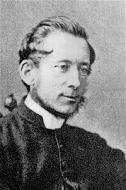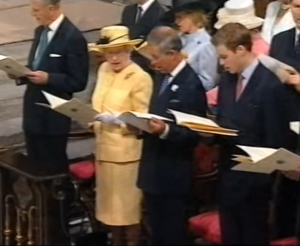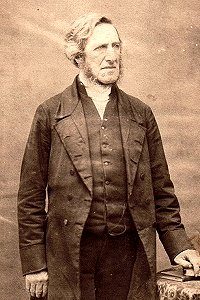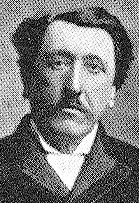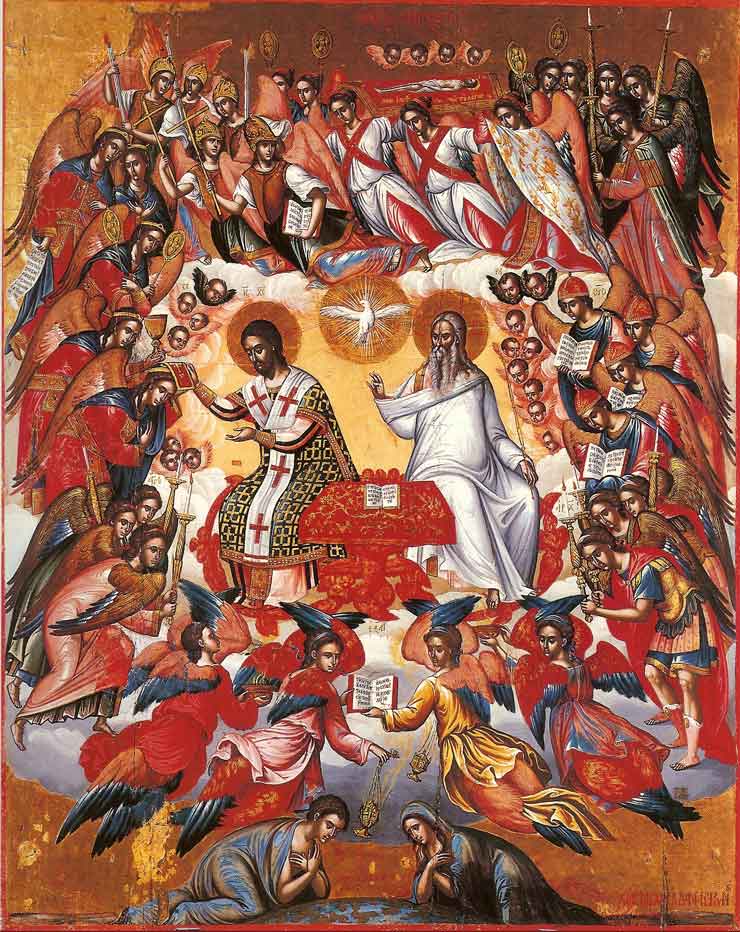Crown Him with Many Crowns, 1851: Anglican Matthew Bridges (1800-1894) wrote six verses of this hymn, which is based on Rev: 1: 12: “and on His head were many crowns.” But Bridges converted to Catholicism, and Godfrey Thring (1823-1903) thought the hymn was too Catholic, and wrote six more verses, so hymnals, depending on their leanings, use different selections of verses. In the 1940 Hymnal the first and last verses are by Bridges, the middle three by Thring.
Matthew Bridges was born at Malden, Essex, on July 14, 1800. He began his literary career with the publication of a poem, “Jerusalem Regained,” in 1825; followed by a book entitled The Roman Empire under Constantine the Great, in 1828, its purpose being to examine “the real origin of certain papal superstitions.” As a result of the influence of John Henry Newman and the Oxford Movement, Bridges became a Roman Catholic in 1848, and spent the latter part of his life in Canada. He returned to England to live in a small villa at the Convent of the Assumption at Sidmouth, Devon, where he died in 1894.
Bridges’ stanzas:
Crown Him with many crowns,
The Lamb upon His throne;
Hark! how the heavenly anthems drowns
All music but its own:
Awake, my soul, and sing
Of Him who died for thee,
And hail Him as thy matchless King
Through all eternity.
Crown Him the Virgin’s Son!
The God Incarnate born,—
Whose arm those crimson trophies won
Which now His brow adorn!
Fruit of the mystic Rose
As of that Rose the Stem:
The Root, whence mercy ever flows,—
The Babe of Bethlehem!
Crown Him the Lord of peace!
Whose power a scepter sways,
From pole to pole,—that wars may cease,
Absorbed in prayer and praise:
His reign shall know no end,
And round His pierced feet
Fair flowers of paradise extend
Their fragrance ever sweet.
Crown Him the Lord of love!
Behold His hands and side,—
Rich wounds, yet visible above,
In beauty glorified:
No angel in the sky
Can fully bear that sight,
But downward bends his burning eye
At mysteries so bright!
Crown Him the Lord of years!
The Potentate of time,—
Creator of the rolling spheres,
Ineffably sublime!
Glassed in a sea of light,
Where everlasting waves
Reflect His throne,—the Infinite!
Who lives,—and loves—and saves.
Crown Him the Lord of heaven!
One with the Father known,—
And the blest Spirit, through Him given
From yonder triune throne!
All hail! Redeemer,—Hail!
For Thou hast died for me;
Thy praise shall never, never fail
Throughout eternity!
Thring’s stanzas:
Crown Him with crowns of gold,
All nations great and small,
Crown Him, ye martyred saints of old,
The Lamb once slain for all;
The Lamb once slain for them
Who bring their praises now,
As jewels for the diadem
That girds His sacred brow.
Crown Him the Son of God
Before the worlds began,
And ye, who tread where He hath trod,
Crown Him the Son of man;
Who every grief hath known
That wrings the human breast,
And takes and bears them for His own,
That all in Him may rest.
Crown Him the Lord of light,
Who o’er a darkened world
In robes of glory infinite
His fiery flag unfurled.
And bore it raised on high,
In heaven-in earth-beneath,
To all the sign of victory
O’er Satan, sin, and death.
Crown Him the Lord of life
Who triumphed o’er the grave,
And rose victorious in the strife
For those He came to save;
His glories now we sing
Who died, and rose on high.
Who died, eternal life to bring
And lives that death may die.
Crown Him of lords the Lord,
Who over all doth reign
Who once on earth, the incarnate Word,
For ransomed sinners slain,
Now lives in realms of light,
Where saints with angels sing
Their songs before Him day and night,
Their God, Redeemer, King.
Crown Him the Lord of heaven,
Enthroned in worlds above;
Crown Him the King, to whom is given
The wondrous name of Love,
Crown Him with many crowns,
As thrones before Him fall.
Crown Him, ye kings, with many crowns,
For He is King of all.
As Benjamim Kolodziej explains:
Thring has eliminated that which most reflects Roman Catholic doctrine. Gone are the references to the Mystic Rose, the stanza extolling Christ’s glorious wounds, and the entire tenor of the hymn is reduced in its triumphalism. Thring personalizes that Christ whom Bridges describes as “The God Incarnate born” when Thring writes of Christ “who every grief hath known that wrings the human breast.” Whereas Bridges’s text bears an almost creedal hallmark, Thring’s exhibits a personal response to this credo. Although both hymns are Christocentric and refer to Christ’s salvific atonement in specific ways, Thring includes a stanza which very specifically elucidates the atonement. The fourth stanza, which most modern hymnals incorporate into their setting of the hymn, sings of the “Lord of Life” “who died-Eternal Life to bring, and lives that death may die.” Thring continues noting “th’Incarnate Word for ransomed sinners slain,” employing not only Biblical language but also terminology which would have been a bit more pedestrian to Victorian sensibilities. Bridges’s hymn refers to the atonement only thrice-when he sings “Of Him who died for thee,” when he notes Christ “lives, and loves, and saves” and when his final doxology proclaims, “For Thou hast died for me.” Bridges’s text is couched in poetic grandeur and eschatological mystagogy before it proclaims redemption, while Thring’s text only manages to evoke heavenly splendor after firmly grounding the text within human terms, “all nations great and small.”
Godfrey Thring
Godfrey Thring was born at Alford, Somerset, the son of the rector, Rev. John Gale Dalton Thring and Sarah née Jenkyns. He was brother of Theodore Thring (1816–91), Henry, Lord Thring (1818–1907) (a noted jurist and Parliamentary Counsel to the Treasury), Edward Thring (headmaster of Uppingham School) and Rev. John Charles Thring (a master at Uppingham School and deviser of the Uppingham or Cambridge Rules of football), and two sisters. The family is commemorated in Alford Church by carved choir seats in the chancel and two memorial windows.
He was educated at Shrewsbury School and graduated in 1845 from Balliol College, Oxford with a BA. He was ordained in the Anglican Church. In 1858 his father united the benefices of Alford and Hornblotton by an Act of Parliament styled the “Thrings Estate Bill” and Godfrey became his father’s curate. He built Hornblotton Rectory for Godfrey in 1867.
Godfrey commissioned the architect Thomas Graham Jackson to build new churches at Hornblotton and Lottisham, and became, in Jackson’s words, “one of my best and most valued friends”. Jackson created for him a remarkable little church, rich in the Arts and Crafts style and strikingly decorated in sgraffito work.
Thring died in 1903 and was buried in Shamley Green, Surrey, England.
His hymnography did not impress all his contemporaries. One wrote that Thring’s A Church of England Hymn Book (1880) amounted to little more than “thick, squat book, in a sadcoloured green cloth binding,” the only laudatory comment being the final sentence, “The book is well indexed.”
Thring’s church at Hornblotton
(I did not make up any of these names)
The hymn was sung in Westminster Abbey at the 50th anniversary of the coronation of Queen Elizabeth. The announcer misinforms the British public that the words are by George Eliot.
One person commented:
I always like the looks on the Royals’ faces as they look around when those sopranos are reaching those high notes at the top of their lungs. It’s kind of funny.
Anthem: O Jesus, King Most Wonderful is a contrafactum: a piece of music in which one text has been substituted for another. The text is an English translation of a hymn of Bernard of Clairvaux (Jesu Rex Admirabilis, circa 1153) by Edward Caswall (circa 1848). Caswall was an Oxford graduate and Anglican priest that was received into the Catholic church in the 1840s and joined the Birmingham Oratory. The hymn depicts Jesus as a King and conqueror but also as the source of light and life. The music by Christopher Tye (1500-1573) was originally set to a different sacred English text in a simple, clear, and primarily homophonic texture so typical of the English Reformation.
IESU, Rex admirabilis
et triumphator nobilis,
dulcedo ineffabilis,
totus desiderabilis.
O JESUS, King most wonderful!
Thou Conqueror renowned!
Thou Sweetness most ineffable!
in whom all joys are found!
Quando cor nostrum visitas,
tunc lucet ei veritas,
mundi vilescit vanitas,
et intus fervet caritas.
When once Thou visitest the heart,
then truth begins to shine;
then earthly vanities depart;
then kindles love divine.
Iesu, dulcedo cordium,
fons vivus, lumen mentium,
excedens omne gaudium
et omne desiderium.
O Jesu! Light of all below!
Thou font of life and fire!
surpassing all the joys we know,
and all we can desire.
Iesum omnes agnoscite,
amorem eius poscite;
Iesum ardenter quaerite,
quaerendo inardescite.
May every heart confess Thy name,
and ever Thee adore;
and seeking Thee, itself inflame
to seek Thee more and more.
Te nostra, Iesu, vox sonet,
nostri te mores exprimant;
te corda nostra diligant
et nunc, et in perpetuum
The Head that Once was Crowned with Thorns. Thomas Kelly (1769-1854) based this hymn on Hebrews 2: 9-10 which speaks of Christ’s glory and the universal message of grace that is available because of Christ’s suffering: “But we see Jesus, who was made a little lower than the angels for the suffering of death, crowned with glory and honor; that he by the grace of God should taste death for every man. For it became him, for whom are all things, and by whom are all things, in bringing many sons unto glory, to make the captain of their salvation perfect through sufferings.”
Kelly employs the poetic device of hypotyposis – a vivid description of a scene or events in words – that provides the singer with a glimpse of the splendor of heaven, which is contrasted with the suffering of the cross and the suffering of all who follow Christ on earth.
Thomas Kelly
Son of a judge, Kelly attended Trinity College (BA 1789) and planned to be a lawyer. After converting to Christ, though, his career plans changed to the ministry. He became an Anglican priest in 1792, but eventually became one of the famous dissenting ministers. He wrote over 760 hymns. Miller’s Singers of the Church (1869) says of him:
Mr. Kelly was a man of great and varied learning, skilled in the Oriental tongues, and an excellent Bible critic. He was possessed also of musical talent, and composed and published a work that was received with favour, consisting of music adapted to every form of metre in his hymn-book. Naturally of an amiable disposition and thorough in his Christian piety, Mr. Kelly became the friend of good men, and the advocate of every worthy, benevolent, and religious cause. He was admired alike for his zeal and his humility; and his liberality found ample scope in Ireland, especially during the year of famine.
Anthem: O God the King of Glory is an anthem by Henry Purcell (1659 – 1695), the most famous of the few Englishmen who composed in the baroque style. Purcell composed music for the stage and had a keen sense of drama. This piece implores God, the King of Glory, who exalted Christ to heaven, not to leave us comfortless. The first few measures introduce the King with a nod to the French baroque overture, then uses rising phrases to convey the sense of exaltation, then arrives in heaven on a high D major chord. It then turns to striking chromatic harmonies that convey the sense of pleading for the comfort and companionship of the Holy Ghost. Here it is sung by Voces XII.
Alleluia! Sing to Jesus. William Dix (1837-1898), an Anglican High Churchman, wrote this deeply Catholic Eucharistic hymn. Jesus is King and High Priest, who, wearing “robes of flesh,” our human nature, has entered “within the veil” in the heavenly Temple. He is high priest both there and at the altar, where he offers himself to His Father and unites us to Himself in that offering when we receive His sacrificed body and blood in faith.
J. R. Watson’s analysis:
What Dix has done is to allude to different passages of scripture in a dense interlocking weave, in a manner that had not been practised since the work of Charles Wesley. In this hymn, Dix—perhaps unconsciously—picks up Wesley’s intertextual method and applies it, using the Gospels, the Epistles, and Revelation:
Intercessor, friend of sinners,
Earth’s Redeemer, plead for me,
Where the songs of all the sinless
Sweep across the crystal sea.
The rhetoric of the first verse (‘His the sceptre … his the triumph’) gives way to a sudden cry, as though the spirit of Neale was married to the spirit of Toplady; and the hymn then swings into its vision of the crystal sea, from Revelation 4. Dix then brings it back to earth with a final reference to the Holy Communion:
Thou on earth both priest and victim,
In the eucharistic feast.
Jesus is ‘the great high priest’, and the figures of Aaron and Melchisedec are blended with the figure of the crucified Saviour. Dix compresses volumes of systematic theology into the verse-form, and it is that compression which gives the hymn a distinction not seen since the eighteenth century.
William Chatterton Dix
According to Wikipedia:
William Chatterton Dix (14 June 1837 – 9 September 1898) was an English writer of hymns and carols. He was born in Bristol, the son of John Dix, a local surgeon, who wrote The Life of Chatterton the poet, a book of Pen Pictures of Popular English Preachers and other works. His father gave him his middle name in honour of Thomas Chatterton, a poet about whom he had written a biography. He was educated at the Grammar School, Bristol, for a mercantile career, and became manager of a maritime insurance company in Glasgow where he spent most of his life.
Few modern writers have shown so signal a gift as his for the difficult art of hymn-writing. His original hymns are found in most modern hymn-books. He wrote also felicitous renderings in metrical form of Richard Frederick Littledale’s translations from the Greek in his Offices of the Holy Eastern Church; and of Rodwell’s translations of Abyssinian hymns. Some of his carols, such as The Manger Throne, have been very popular. His hymns and carols also include As with Gladness Men of Old, What Child Is This?, To You, O Lord, Our Hearts We Raise and Alleluia! Sing to Jesus.
At the age of 29 he was struck with a near fatal illness and consequently suffered months confined to his bed. During this time he became severely depressed. Yet it is from this period that many of his hymns date.[4][5] He died at Cheddar, Somerset, England, and was buried at his parish church.
Many of the Anglican hymns celebrating the kingship of Jesus were written as Ascension Day hymns, because on that day Jesus ascended to his Father’s throne and took His seat at the right hand of God.
Michael Damaskenos, Crete 16th c.
